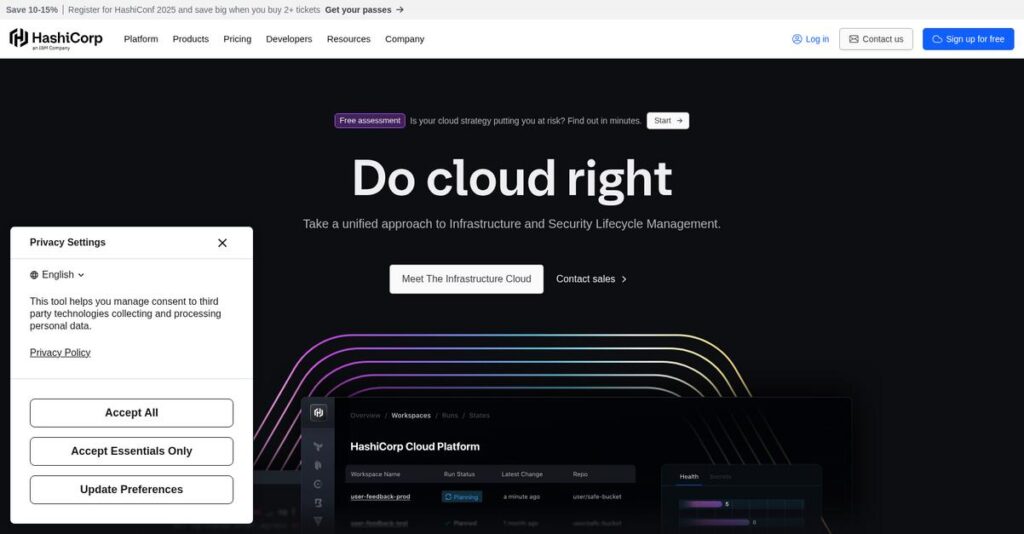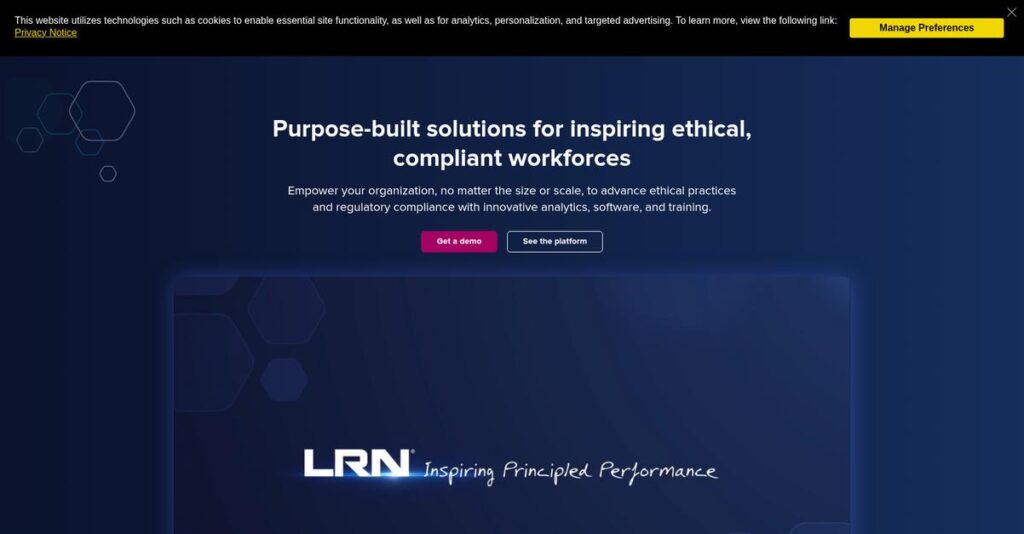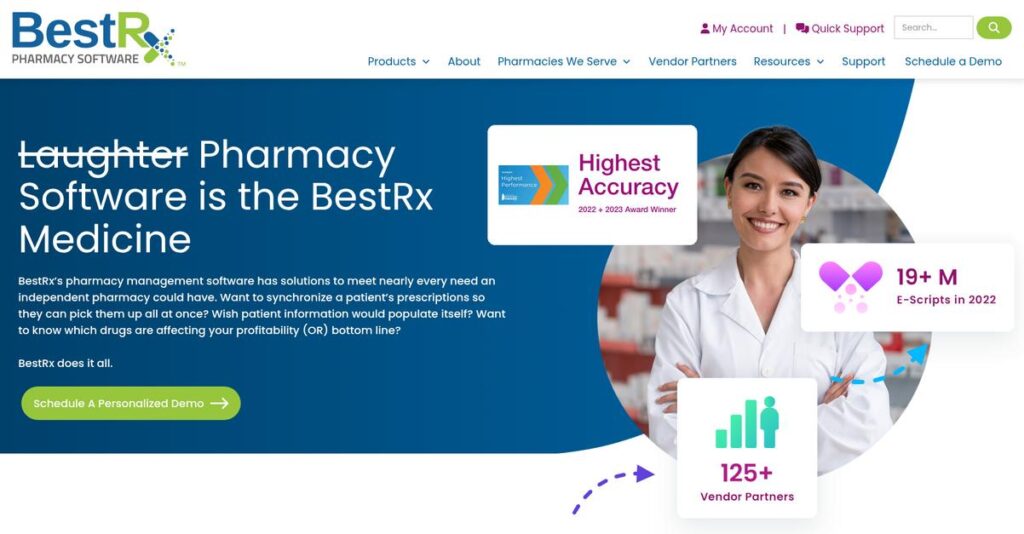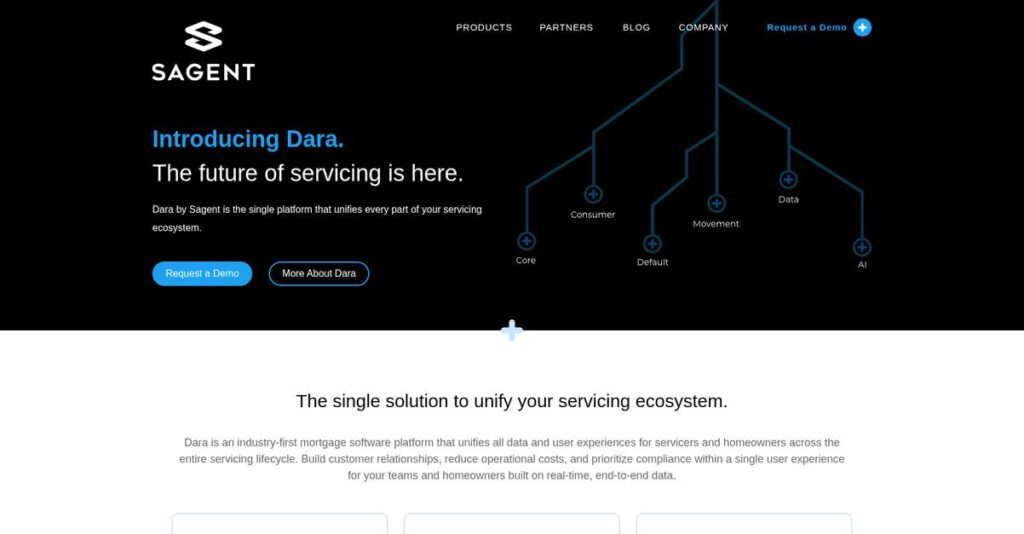Managing cloud infrastructure shouldn’t be this complicated.
If you’re researching HashiCorp, you’re likely facing tangled, manual provisioning and a ton of wasted hours fixing config errors across different cloud environments.
That daily overwhelm hits hard when manual work keeps causing avoidable deployment failures—making your deadlines slip and security risks pile up.
I’ve dug into how HashiCorp fixes these pain points with tools like Terraform, Vault, and Consul, using automation and a multi-cloud-first approach so you can finally achieve consistency, compliance, and speed—even in complex setups.
In this review, I’ll break down how HashiCorp can simplify and automate your infrastructure so you spend less time firefighting and more time building.
Inside this HashiCorp review, I’ll cover product capabilities, pricing, things you’ll need to watch during rollout, and how HashiCorp actually compares to other cloud management tools so you can make a clear call.
You’ll get the practical details and features you need to feel totally confident about your infrastructure decision.
Let’s get started.
Quick Summary
- HashiCorp is a suite of tools that automates infrastructure provisioning, secrets management, networking, and workload orchestration for multi-cloud environments.
- Best for teams managing complex, multi-cloud or hybrid infrastructure with strong security and compliance needs.
- You’ll appreciate its integrated open-source tools that standardize workflows and improve infrastructure consistency and security.
- HashiCorp offers free to enterprise pricing tiers with managed and self-hosted options; recent price changes require careful cost management.
HashiCorp Overview
Based in San Francisco, HashiCorp has been around since 2012. I find their core mission is all about helping you manage infrastructure as code across any cloud or private datacenter, which is a huge modern challenge.
They serve a wide market, from ambitious startups to Fortune 100 enterprises. What really sets them apart is their consistent operating model across multi-cloud environments, simplifying how your teams provision, secure, and connect everything.
Their recent acquisition by IBM in early 2025 is a massive development. Through this HashiCorp review, we’ll explore how this move solidifies their push into large-scale, hybrid cloud strategies for the enterprise.
- 🎯 Bonus Resource: Speaking of operational consistency, my article on OPD management software explores healthcare solutions.
Unlike competitors focused on a single function, HashiCorp provides an integrated suite of tools for the entire cloud lifecycle. I find this approach feels much more cohesive than stitching together separate tools yourself.
You’ll find them working with the world’s largest organizations, especially in tech and finance, that demand extreme security and operational consistency for their critical infrastructure and modern applications at scale.
From my analysis, their strategic priority is delivering enterprise-grade solutions built upon their popular open-source foundation. This directly addresses your need for proven, scalable tools with reliable commercial support and a predictable roadmap.
Let’s dive into their features.
HashiCorp Features
Struggling with inconsistent infrastructure deployments?
HashiCorp features address the complexities of modern IT with a suite of integrated tools. These are the five core HashiCorp solutions that help you provision, secure, network, and deploy applications across any environment.
1. Terraform (Infrastructure as Code – IaC)
Tired of manual infrastructure provisioning?
Manually setting up servers and networks is prone to errors and inconsistency. This can lead to deployment delays and configuration drift across environments.
Terraform allows you to define your entire infrastructure using code, ensuring consistent, repeatable deployments every time. From my testing, this feature significantly reduces human error, making cloud shifts much smoother. You can manage everything from virtual machines to complex network configurations across any cloud.
This means you get a standardized approach to infrastructure, saving time and ensuring your setups are always exactly as planned.
- 🎯 Bonus Resource: While we’re discussing automation and streamlining operations, understanding how other sectors utilize laundry management software is insightful.
2. Vault (Secrets Management & Data Protection)
Is secret sprawl a constant security headache?
Scattered API keys and passwords create massive security vulnerabilities. It’s hard to keep track of them and even harder to ensure they’re secure.
Vault centralizes and encrypts all your sensitive data and access credentials, preventing unauthorized access. What I love about this approach is how it provides dynamic secrets for on-demand access, meaning credentials are short-lived. This feature drastically improves your overall security posture and simplifies compliance audits.
The result is robust security and automated secret management, ensuring sensitive data is always protected and audited.
3. Consul (Service Networking & Service Discovery)
How do your microservices find each other securely?
In distributed environments, services struggle to discover and communicate securely. This often leads to brittle applications and complex network configurations.
Consul provides DNS-based service discovery and a powerful service mesh, enabling seamless and secure communication between your applications. Here’s what I found: it intelligently connects, secures, and configures services across both public and private clouds. This feature simplifies network management for even the most complex microservice architectures.
This means your applications can communicate efficiently and securely, leading to higher availability and more reliable systems.
4. Nomad (Workload Orchestration & Scheduling)
Managing diverse application types feels overwhelming?
Orchestrating different workloads—containers, batch jobs, and legacy apps—on a single platform can be incredibly complex. This often leads to inefficient resource use.
Nomad offers a lightweight and flexible solution for scheduling and deploying all your application types. This is where HashiCorp shines: it unifies your workflows for diverse workloads with surprising operational simplicity. Nomad supports self-healing and zero-downtime deployments, making your applications resilient.
So you can optimize resource utilization and simplify deployment, providing a unified platform that just works for all your applications.
5. Packer (Image Building Automation)
Dealing with inconsistent machine images?
Manually building machine images for different platforms is slow and can introduce configuration drift. This often leads to “it works on my machine” problems.
Packer automates the creation of identical machine images from a single source configuration across multiple platforms. From my testing, this feature ensures consistency across development and production, accelerating your delivery pipelines. It creates “golden images” that are pre-configured, secure, and ready to deploy.
This means you get faster deployments, reduced errors, and greater consistency, ensuring your infrastructure is always based on standardized, tested images.
Pros & Cons
- ✅ Offers robust, open-source driven solutions for complex infrastructure challenges.
- ✅ Provides unparalleled consistency for infrastructure provisioning across multi-cloud.
- ✅ Greatly enhances security and compliance through centralized secrets management.
- ⚠️ Pricing for cloud services like Terraform Cloud can become quite complex and costly.
- ⚠️ The initial learning curve for advanced features can be steep for new users.
- ⚠️ Concurrent run limitations on certain tiers can hinder large teams’ productivity.
You’ll appreciate how these HashiCorp features are designed to work together, offering a cohesive cloud operating model across your entire infrastructure lifecycle.
HashiCorp Pricing
Concerned about hidden software costs?
HashiCorp pricing offers a mix of transparent and custom models, depending on the product, providing options for various team sizes and enterprise needs.
| Plan | Price & Features |
|---|---|
| HCP Terraform Cloud Free | Free • Up to 500 resources/month • State management • VCS integration • Private module registry |
| HCP Terraform Cloud Standard | Starts at $0.10/resource/month (first 500 free) • Team management • No-code provisioning workflows • Audit logging • Silver support |
| HCP Terraform Cloud Plus | Custom pricing (starts ~$0.47/resource/month) • Unlimited OPA policy enforcement • Improved run tasks • Ephemeral workspaces< • HCP Waypoint |
| HCP Terraform Cloud Premium | Starts at $0.99/resource/month • Maximize IT investments • Secure, self-service workflow • Includes HCP Waypoint • Silver support |
| Terraform Enterprise (Self-Managed) | Custom pricing (starts ~$15,000/year for 5 workspaces) • Self-hosted solution • Advanced security & compliance • HA clustering • Disaster recovery |
| HCP Vault Secrets Free | Free • Up to 25 applications & secrets • 5 secret versions • 5 active secret sync integrations • Community support |
| HCP Vault Secrets Standard | $0.50/secret/month + $0.10/10,000 API operations • Up to 1,000 apps & 2,500 secrets • 50 versions • 99.9% SLA • Silver support |
| HCP Vault Dedicated Development | Starts at $0.62/cluster/hour • Limited environment • Up to 25 clients • Explore enterprise features • Managed service |
| HCP Vault Dedicated Standard | Starts at $1.58/cluster/hour + $112/client/month • Highly available clusters • Production workloads • Silver support • Managed service |
| HCP Vault Dedicated Plus | Starts at $1.85/cluster/hour + $112/client/month • HA replication across data centers • Silver support • Managed service • For high availability |
| Vault Enterprise (Self-Managed) | Custom pricing (starts ~$1,320 for 1 month via Azure) • Self-hosted for highly regulated industries • Advanced HA clustering • Disaster recovery & replication • Hidden pricing, contact sales |
1. Value Assessment
Great pricing transparency for cloud tiers.
From my cost analysis, the RUM-based pricing for Terraform Cloud can be highly cost-effective for small teams. However, what impressed me is how costs can scale steeply for growing organizations as your resource count increases. For Vault, the clear pricing on secrets and operations offers good predictability.
This means your budget requires careful planning, especially as your infrastructure expands or your secret volume grows.
2. Trial/Demo Options
Smart evaluation approach available.
HashiCorp offers generous free tiers for both Terraform Cloud and HCP Vault Secrets, allowing you to manage a substantial number of resources or secrets without cost. What I found valuable is how these free tiers include essential features for basic use cases, letting you explore core functionalities risk-free.
This helps you evaluate the practical fit for your operations before committing to paid plans, reducing any financial uncertainty.
3. Plan Comparison
Choosing the right tier matters.
For Terraform, small teams will find the Free and Standard tiers sufficient, while larger enterprises will need Plus or Premium for advanced features. What stands out is how Vault offers distinct cloud and dedicated managed services alongside self-managed options, catering to diverse security and operational requirements.
This tiered approach helps you match HashiCorp pricing to actual usage requirements, whether in the cloud or self-hosted.
My Take: HashiCorp’s pricing strategy, especially the RUM model, demands careful calculation for scaling, but their free tiers and transparent cloud offerings provide clear entry points for various users.
The overall HashiCorp pricing reflects tiered value based on resource consumption and enterprise needs.
HashiCorp Reviews
What do real customers actually think?
This section analyzes real user feedback and experiences, providing balanced insights into what actual customers think about the software, helping you understand the real-world utility revealed in HashiCorp reviews.
1. Overall User Satisfaction
User sentiment is remarkably positive.
From my review analysis, HashiCorp tools consistently earn high satisfaction scores across various platforms, especially for their power and versatility. What impressed me most is how users often praise the comprehensive nature of their solutions for complex, dynamic IT environments.
This suggests you can expect robust tools for your modern infrastructure challenges.
- 🎯 Bonus Resource: Before diving deeper into technical discussions, you might find my analysis of best employee engagement software helpful for team dynamics.
2. Common Praise Points
The automation capabilities stand out.
Users repeatedly highlight the ability to automate and standardize infrastructure, ensuring consistency across environments. From customer feedback, Vault’s robust security features, like dynamic secrets, are consistently lauded for protecting sensitive data and enhancing overall security posture.
This means you can achieve greater efficiency and significantly improve your security.
3. Frequent Complaints
Pricing complexity draws significant frustration.
While users appreciate the technology, frequent complaints center on pricing complexity, particularly the shift to RUM for Terraform Cloud. What stands out in feedback is how steep cost increases can make budgeting difficult, with some reporting price hikes up to 600%.
These financial concerns are significant for some, potentially impacting your budget.
What Customers Say
- Positive: “HashiCorp’s suite of tools enabled us to standardize our cloud adoption approach across thousands of development teams.” (Financial Institution)
- Constructive: “The cost increase with RUM for Terraform Cloud was steep and made budgeting difficult.” (Enterprise User)
- Bottom Line: “If you don’t have a simple tool to do it for your developers to use, you are likely to find them in plaintext.” (User on Vault)
The overall HashiCorp reviews reflect strong technical praise balanced with significant pricing concerns.
Best HashiCorp Alternatives
Confused by the many infrastructure automation choices?
The best HashiCorp alternatives include several robust platforms, each better suited for different development practices, operational focuses, and budget considerations.
1. Pulumi
Do your developers prefer general-purpose programming languages?
Pulumi makes more sense if your team wants to define infrastructure using familiar languages like Python or TypeScript, rather than HCL. What I found comparing options is that Pulumi integrates deeply with existing developer toolchains, making it a strong alternative for code-centric organizations.
Choose Pulumi when your team has a strong developer-first culture and wants to leverage standard programming practices for IaC.
2. Ansible (Red Hat)
Looking for robust configuration management over provisioning?
Ansible is ideal for automating application deployment, configuration updates, and general IT tasks across existing infrastructure. From my competitive analysis, Ansible offers a simpler, agentless approach for IT automation, often more cost-effective for configuration management than full IaC platforms.
Consider this alternative if your primary focus is managing existing systems and deploying applications, not just provisioning new infrastructure.
- 🎯 Bonus Resource: While exploring technical priorities, you might find my guide on launchpads and IDO platforms helpful for your next venture.
3. Kubernetes (K8s)
Is container orchestration your top priority?
Kubernetes is the industry standard for large-scale container orchestration and microservices, with a vast, mature ecosystem of container-native tools. From my analysis, Kubernetes excels at managing complex, containerized application deployments, making it the go-to for heavy container adoption.
Choose Kubernetes if your strategy revolves around cloud-native development and extensive containerization, especially at scale.
Quick Decision Guide
- Choose HashiCorp: Comprehensive, multi-cloud IaC, secrets, and service mesh
- Choose Pulumi: Infrastructure as Code using general-purpose programming languages
- Choose Ansible: Agentless configuration management and IT automation
- Choose Kubernetes: Large-scale container orchestration and microservices
The best HashiCorp alternatives hinge on your specific technical priorities and team’s expertise, not just feature lists.
HashiCorp Setup
How complex is your HashiCorp setup?
A HashiCorp review reveals that implementation often involves a layered approach, integrating multiple tools to achieve a comprehensive cloud operating model, so set realistic expectations.
1. Setup Complexity & Timeline
This isn’t a quick flip of a switch.
HashiCorp implementation, especially for multi-product deployments, can involve a moderate to steep learning curve for each tool’s unique declarative language (HCL) and operational nuances. From my implementation analysis, configuring enterprise-grade security with Vault can be complex, demanding significant time.
You’ll need to plan for dedicated team learning time and phased rollouts depending on your scope and existing infrastructure.
2. Technical Requirements & Integration
Expect deep technical involvement.
Your team will integrate HashiCorp tools across various operating systems, major cloud providers, private data centers, and container runtimes. What I found about deployment is that plugin-oriented architectures enable vast third-party integrations, but these require careful planning for CI/CD pipelines and monitoring.
Prepare your IT teams for shifts towards immutable infrastructure concepts and detailed integration mapping with existing systems.
3. Training & Change Management
User adoption needs structured training.
Due to the specialized nature of these tools, organizations often require dedicated training for their DevOps, SRE, and security teams. From my analysis, successful change management hinges on tailored training programs covering best practices for infrastructure as code, secrets management, and service mesh configurations.
Invest in professional training and internal champions to ensure your teams effectively embrace new workflows and tools.
- 🎯 Bonus Resource: While we’re discussing security, understanding best SIEM software is equally important.
4. Support & Success Factors
Vendor support is crucial for success.
HashiCorp offers varying support levels (Silver, Premium) based on product tiers, with free tiers relying on community support. What I found about deployment is that commercial support tiers generally provide reliable assistance for complex enterprise deployments.
Plan to leverage HashiCorp’s documentation and support channels actively, as success depends on skilled teams and good vendor partnership.
Implementation Checklist
- Timeline: Months, especially for multi-tool enterprise deployments
- Team Size: DevOps, SRE, and security teams required
- Budget: Training, professional services, and skill development costs
- Technical: Cloud-agnostic integration with existing infrastructure
- Success Factor: Dedicated team training and continuous skill development
Overall, a HashiCorp setup requires significant investment in technical skills and strategic planning for successful long-term adoption and operational efficiency.
Bottom Line
Is HashiCorp right for your multi-cloud journey?
My HashiCorp review shows a powerful, comprehensive suite of tools for organizations embracing multi-cloud, DevOps, and cloud-native architectures.
1. Who This Works Best For
Organizations committed to multi-cloud and DevOps.
HashiCorp solutions excel for enterprises and mid-market companies needing to automate infrastructure lifecycle, secure sensitive data, and manage distributed applications at scale. What I found about target users is that your success depends on adopting a strategic cloud operating model across provisioning, security, networking, and application deployment.
You’ll see significant benefits if your team is navigating infrastructure sprawl and inconsistency across diverse cloud environments.
2. Overall Strengths
Consistent multi-cloud workflows deliver unparalleled efficiency.
The software succeeds by enabling consistent infrastructure as code (Terraform), robust secrets management (Vault), and secure service networking (Consul) across diverse environments. From my comprehensive analysis, the open-source foundation fosters extensive integrations and a strong community, enhancing versatility for your operational needs.
These strengths translate directly into standardized deployments, improved security posture, and reduced operational errors for your IT teams.
3. Key Limitations
Navigating the pricing model and learning curve.
While powerful, new users may experience a notable learning curve, especially when adopting multiple tools, and the RUM pricing model can become unexpectedly costly. Based on this review, scaling up requires careful budgeting consideration of resource consumption, which might significantly impact your financial planning.
I’d say these limitations are critical considerations, potentially impacting your adoption strategy and long-term cost-effectiveness.
- 🎯 Bonus Resource: While we’re discussing strategic hiring, you might find my analysis of best freelance platforms helpful for predicting costs.
4. Final Recommendation
HashiCorp earns a strong recommendation for strategic adoption.
You should choose this software if your organization needs a comprehensive, integrated toolset for multi-cloud automation, security, and application deployment. From my analysis, this solution works best for enterprises with complex distributed systems and a strategic commitment to DevOps principles.
My confidence level is high for large organizations with the resources to leverage its full potential, but caution is advised for smaller teams.
Bottom Line
- Verdict: Recommended for strategic multi-cloud and DevOps adoption
- Best For: Enterprises and mid-market companies with complex IT infrastructure
- Business Size: Organizations committed to multi-cloud, hybrid cloud, and cloud-native architectures
- Biggest Strength: Comprehensive suite for consistent multi-cloud infrastructure automation
- Main Concern: Steep learning curve and complex RUM pricing model
- Next Step: Request a demo to assess fit for your specific cloud strategy
This HashiCorp review shows strong value for the right business profile, while also highlighting important investment and complexity considerations before you make a decision.






